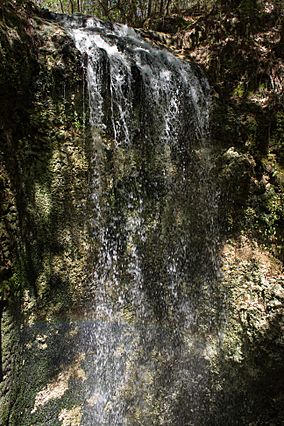Falling Waters State Park facts for kids
Quick facts for kids Falling Waters State Park |
|
|---|---|

Falling Waters
|
|
| Location | Washington County, Florida, United States |
| Area | 171 acres (69 ha) |
| Elevation | 239 ft (73 m) |
| Established | 1962 |
| Named for | Falling Water Falls |
| Visitors | 30000 (in in 2008) |
| Governing body | Florida Division of Recreation and Parks |
| Website | Falling Waters State Park |
Falling Waters State Park is a cool place in Florida with a tall waterfall! It's about 171 acres big and is located in Washington County, near a town called Chipley. The park is famous for "Falling Waters Falls," which is the highest waterfall in Florida. It drops about 73 feet into a big hole in the ground.
Contents
A Look Back in Time: Park History
The interesting sinkholes at Falling Waters State Park were once used as hiding spots. Native American warriors hid here when they were fighting against Andrew Jackson during the Seminole Wars. These wars were a series of conflicts between Native Americans and the United States in Florida.
The park is also home to the remains of an old gristmill. A gristmill was a building where grain was ground into flour. This mill used the power of the waterfall in Falling Waters Sink to work! Later, in 1891, a place to make alcohol, called a distillery, was built on the same spot.
Florida's First Oil Well
Did you know the first oil well in Florida was drilled right here? It happened in 1919. People started drilling based on old local stories and a Spanish diary from 400 years ago! The well went very deep, about 4,912 feet down. However, it never found enough oil to be useful, so it was closed in 1921.
Becoming a State Park
Falling Waters became a state park in 1962. The Washington County Development authority gave the land to the state. Soon after, new things like picnic areas and restrooms were built for visitors.
In 2007, scientists from the University of West Florida dug around the park. They found old Native American items that were between 1,000 and 1,500 years old! These finds included pieces of pottery and arrowheads. They even found what might be the only cave painting in Florida! The scientists believe that the waterfall, which attracts visitors today, also drew Native Americans to this special spot long ago. They also found parts of the old gristmill, distillery, and oil well.
Amazing Geology: Sinkholes and Waterfalls
Florida has many hidden underground caves, sinkholes, and springs. These are formed because Florida sits on a layer of limestone. Over millions of years, water has slowly worn away the limestone, creating these cool features. The top layer of Florida's land is made of sandy soils. These sands were left behind by ancient beaches as sea levels changed over time.
Falling Waters State Park is built on this limestone. Water has carved out the sinkholes and caverns you see throughout the park.
The Falling Waters Sinkhole
The famous waterfalls at Falling Waters State Park drop into a 100-foot deep sinkhole called Falling Waters Sink. The amount of water flowing over the falls depends on how much rain Florida gets. The water from the falls then disappears into a large cavern at the bottom of the sinkhole. You can visit this amazing sinkhole! There's a paved trail and a boardwalk that lets you get close to it.
Fun Activities: Recreation at the Park
Falling Waters State Park is open all year for lots of fun activities! You can go camping, fishing, hiking, and even swimming.
The park is well-known for its campfire circles. Park rangers often give interesting talks around the campfires. They might even show a slide show about the park's history or nature.
Camping at the Park
The main campground is on one of the highest hills in Florida, at about 324 feet high. It has 24 campsites. Each site has electricity, fresh water, picnic tables, grills, and a clothesline. It's a great spot for a family camping trip!
Lake Activities
There's also a 2-acre lake where you can go swimming and fishing. It's a perfect place to cool off on a warm Florida day or try to catch some fish.
Gallery






